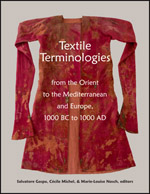Center, Textile Research

Textile Terminologies from the Orient to the Mediterranean and Europe, 1000 BC to 1000 AD
Date of this Version
2017
Document Type
Article
Citation
In Textile Terminologies from the Orient to the Mediterranean and Europe, 1000 BC to 1000 AD, ed. Salvatore Gaspa, Cécile Michel, & Marie-Louise Nosch (Lincoln, NE: Zea Books, 2017), pp. 437-450.
doi:10.13014/K2WD3XRF
Abstract
In May 2002, a burial site was found in Bijiatan, Huahai, in the Gansu province. During the following two months, the Gansu Institute of Archaeology excavated the graveyard and 55 tombs were excavated in total. A female corpse wrapped in several layers of silk garments was found in tomb 26 together with a burial inventory.
The Burial Inventory from Tomb 26: A burial inventory is a list of buried items that would accompany the deceased to the afterlife. It was commonly found in the tombs in northwest China during the 4th to 7th centuries AD.The inventory of Tomb 26 is a rectangular pine wood tablet with characters written on both sides. On one side of the inventory are the names and numbers of the garments and other articles buried in the tomb; on the other side is the name of the tomb owner and the year in which she had died. According to the record, the tomb occupant was “the eldest daughter Gounv Sun” who lived in the Eastern Jin Dynasty and died in the year 377 AD. Three columns and a total of 35 items are recorded in the inventory: ...
Most of the items listed in the burial inventory are the clothing items and accessories used by the owner of the tomb and 25 of them are associated with textiles or costumes. The materials for the costume include silk and hemp. Lian, degummed plain weave silk, were used mostly. The smaller quantities are more likely to be descriptions of real items while larger quantities (500 bolts) probably represent desired amounts for use in the next world. The burial inventory is important for identifying the accurate date of the tomb, and for providing the names of garments to match with the excavated items.
Included in
Ancient History, Greek and Roman through Late Antiquity Commons, Art and Materials Conservation Commons, Classical Archaeology and Art History Commons, Classical Literature and Philology Commons, Fiber, Textile, and Weaving Arts Commons, Indo-European Linguistics and Philology Commons, Jewish Studies Commons, Museum Studies Commons, Near Eastern Languages and Societies Commons, Other History of Art, Architecture, and Archaeology Commons


Comments
Copyright © 2017 Salvatore Gaspa, Cécile Michel, & Marie-Louise Nosch. Photographs copyright as noted.